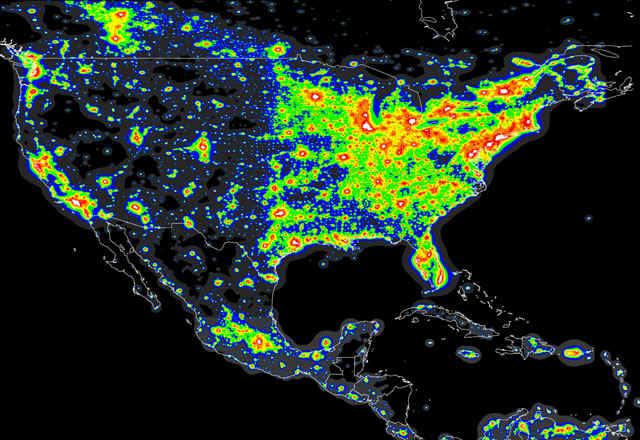

Map source: http://www.inquinamentoluminoso.it/dmsp/index.html
| Color | Artificial / Natural Sky Brightness |
Sky Brightness mags / sq arcsec |
Bortle Scale approx |
Description (Descriptions are approximate. Your sky may vary.) |
| < 0.01 | >21.6 | 1 | Gegenschein visible. Zodiacal light annoyingly bright. Rising milkyway confuses some into thinking it's dawn. Limiting magnitude 7.6 to 8.0 for people with exceptional vision. | |
| 0.01 to 0.11 | 21.6 to 21.5 | 2 | Faint shadows cast by milkyway visible on white objects. Clouds are black holes in the sky. No light domes. The milky way has faint extentions making it 50 degrees thick. Limiting magntiude 7.1 to 7.5. | |
| 0.11 to 0.33 | 21.5 to 21.3 | 3 | Low light domes (10 to 15 degrees) on horizon. M33 easy with averted vision. M15 is naked eye. Milky way shows bulge into Ophiuchus. Limiting magnitude 6.6 to 7.0. | |
| 0.33 to 1.0 | 21.3 to 20.8 | 4 | Zodiacal light seen on best nights. Milkyway shows much dark lane structure with beginnings of faint bulge into Ophiuchus. M33 difficult even when above 50 degrees. Limiting magnitude about 6.2 to 6.5. | |
| 1.0 to 3.0 | 20.8 to 20.1 | 4.5 | Some dark lanes in milkyway but no bulge into Ophiuchus. Washed out milkyway visible near horizon. Zodiacal light very rare. Light domes up to 45 degrees. Limiting magnitude about 5.9 to 6.2. | |
| 3.0 to 9.0 | 20.1 to 19.1 | 5 | Milkyway washed out at zenith and invisible at horizon. Many light domes. Clouds are brighter than sky. M31 easily visible. Limiting magnitude about 5.6 to 5.9. | |
| 9.0 to 27.0 | 19.1 to 18.0 | 6 or 7 | Milkyway at best very faint at zenith. M31 difficult and indestinct. Sky is grey up to 35 degrees. Limiting magntidue 5.0 to 5.5. | |
| >27.0 | <18.0 | 8 or 9 | Entire sky is grayish or brighter. Familliar constellations are missing stars. Fainter constellations are absent. Less than 20 stars visible over 30 degrees elevation in brigher areas. Limiting magntude from 3 to 4. Most people don't look up. |